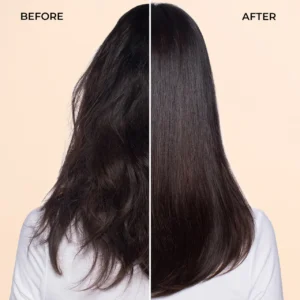1. Introduction
Ever looked at the back of your hair serum bottle and thought — what is all this stuff?
You’re not alone. Hair serums have become a must-have in our daily hair care routines, promising everything from frizz control to heat protection and hair growth. But do you actually know what you’re applying to your strands?
Understanding Hair Serum Ingredients is crucial if you want to get real results and avoid potential hair damage. Whether you’re looking for silky shine, strong strands, or a nourished scalp, it all boils down to what’s inside the bottle.
Let’s get into the science behind those shiny results!
2. What Is a Hair Serum Made Of?
Hair serums are lightweight styling products designed to coat the hair’s surface, providing immediate shine, smoothness, and protection. Depending on the formula, some serums also offer deep treatment benefits that nourish the scalp or strengthen hair over time.
There are different types of hair serums, each created with specific goals in mind:
Types of Hair Serums:
- Frizz Control Serums: These seal the hair cuticle and prevent moisture from entering, helping tame flyaways.
- Shine Enhancing Serums: Infused with gloss-boosting ingredients like silicones or argan oil.
- Growth-Focused Serums: Target the scalp and follicles with clinically backed actives like Redensyl and Procapil.
- Heat Protection Serums: Form a barrier against damage from heat styling tools.
Understanding your goal helps narrow down the ingredients to look for.
3. Must-Have Ingredients in Hair Serum
Let’s break down the best ingredients found in high-quality serums—organized by benefit so you can find what your hair actually needs.
A. For Shine & Frizz Control
✔️ Silicones (Dimethicone, Cyclopentasiloxane):
These smooth the hair surface, reduce frizz, and lock out humidity. They also add instant shine and make detangling easier. Ideal for dry, coarse, or frizzy hair.
✔️ Argan Oil:
Often called “liquid gold,” argan oil is packed with vitamin E and fatty acids. It adds natural shine without making hair greasy and helps reduce breakage.
✔️ Jojoba Oil:
Closely mimics the scalp’s natural oils, making it perfect for moisturizing without weighing the hair down. It’s also excellent for oily or fine hair.
My Picks are
B. For Hair Strength & Repair
✔️ Keratin / Hydrolyzed Proteins:
These ingredients fill in gaps in damaged hair cuticles, strengthening strands and improving texture.
✔️ Panthenol (Vitamin B5):
Known for boosting elasticity, moisture retention, and shine. It penetrates the hair shaft, making strands softer and more manageable.
✔️ Biotin:
A popular hair-strengthening ingredient that promotes healthier hair when combined with proteins or other nourishing actives.
C. For Hair Growth & Scalp Health
✔️ Redensyl:
A science-backed compound that activates hair follicle stem cells and encourages regrowth. It’s often found in premium growth serums.
✔️ Procapil & Anagain:
These natural-based ingredients target hair fall by improving blood circulation in the scalp and strengthening follicles.
✔️ Niacinamide:
Soothes an irritated scalp, improves barrier function, and may help reduce sebum for oily scalps.
My Picks are
4. Ingredients to Be Cautious About
Not all ingredients are good for your hair in the long run. Here’s what to watch out for on the label:
A. Drying Alcohols
❌ Ethanol, Isopropyl Alcohol, SD Alcohol
These alcohols are added for faster drying but can strip your hair of natural oils, leaving it dry and brittle.
B. Parabens & Harsh Preservatives
❌ Methylparaben, Propylparaben
Used to extend shelf life, but parabens may cause irritation or hormonal disruption for sensitive individuals.
C. Artificial Fragrance & Dyes
❌ Synthetic Fragrances, Artificial Colors
These can trigger allergies, especially with prolonged use. Fragrance sensitivity is common among people with scalp issues.
D. Heavy Waxes or Non-Breathable Oils
❌ Mineral Oil, Petrolatum
They coat the hair but don’t let it breathe, leading to buildup and clogged follicles, especially for oily or acne-prone skin.
5. How to Choose the Right Hair Serum Based on Ingredients
Here’s a simple table to help you match your hair concerns with the right ingredients and avoid the ones that can do more harm than good.
| Hair Concern | Key Ingredients to Look For | Avoid If Possible |
|---|---|---|
| Frizzy Hair | Silicones, Argan Oil, Vitamin E | Drying Alcohols |
| Hair Fall/Thinning | Redensyl, Procapil, Biotin | Mineral Oil |
| Dry & Damaged Hair | Coconut Oil, Keratin, Panthenol | Strong Alcohols, Synthetic Fragrance |
| Sensitive Scalp | Niacinamide, Aloe Vera, Fragrance-Free Formulas | Parabens, Dyes |
| Oily Hair | Jojoba Oil, Light Silicone Alternatives | Heavy Oils, Waxes |
6. Pro Tips for Reading Serum Labels
Understanding the ingredients list is the first step in smart product choices. Here’s how to decode them:
- Ingredients are listed by concentration. The ones listed first are in higher amounts.
- Look for “hero” ingredients within the first 5–7 items.
- If “fragrance” is listed early—be cautious. At the end? It’s probably in a safe, minimal amount.
- Growth-focused serums should highlight clinical actives like Redensyl, Anagain, or Peptides.
💡 Bonus Tip: When in doubt, search the ingredient on INCI decoder or EWG’s Skin Deep Database to know its safety profile.
7. Final Thoughts
Hair serums are powerful tools—but their effectiveness depends on what’s inside the bottle.
✔️ Want frizz-free, glossy strands? Look for silicones and nourishing oils.
✔️ Need damage repair? Seek out proteins and panthenol.
✔️ Struggling with hair fall? Go for serums with Redensyl, Procapil, or Niacinamide.
✔️ Got a sensitive scalp? Stick with minimalist formulas that are fragrance- and paraben-free.
Don’t fall for flashy marketing or trendy packaging—always read the label. Your hair deserves ingredients that work for it, not against it.
Take your time testing what suits your hair, and be consistent. Hair transformations don’t happen overnight, but with the right ingredients, they absolutely do happen.




